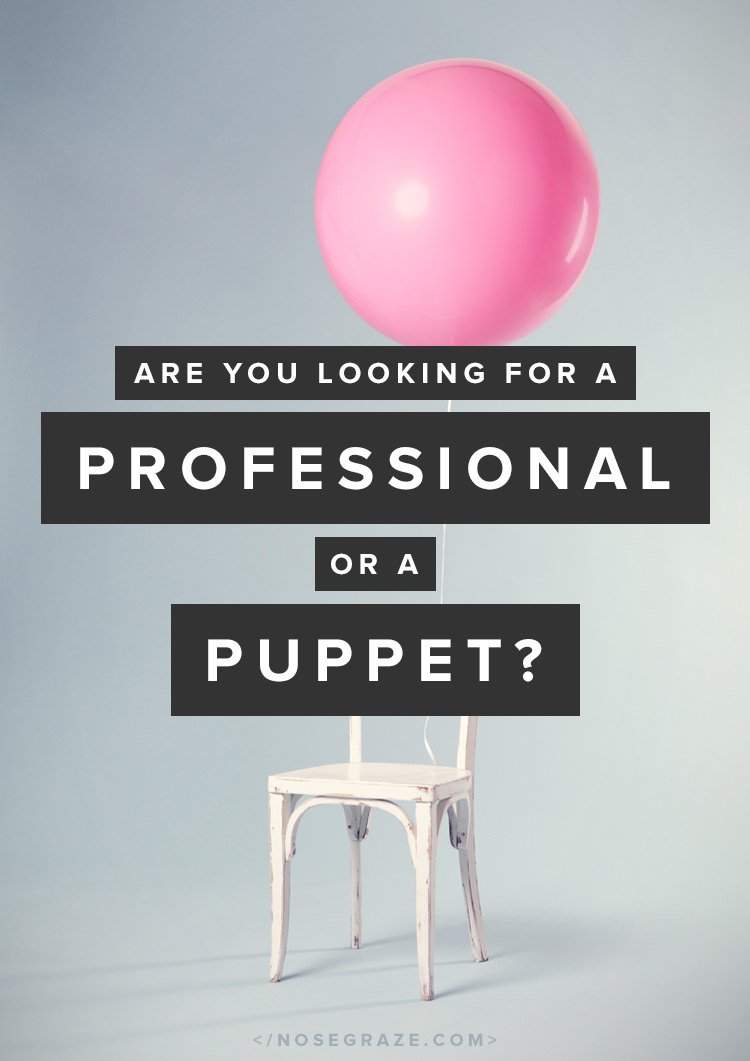
This is something that both clients and freelancers need to figure out.
As a client, what are you looking for?
You want a new website—awesome! But are you looking for a professional or a puppet?
- If you want a professional then you want someone who knows what a good design looks like, who knows how to make your product sell or business thrive or blog rock, and who knows how to put it together in a user-friendly way. You want someone you can trust to make the tough decisions and do what’s best for your site, because you accept that you’re not an expert in design/branding/etc. and you’re not qualified to make those decisions.
- If you want a puppet then you have a clear vision of what you want. It doesn’t mean that the person isn’t good at their job (or professional). It just means that you’re not interested in having someone else make the choices for you. You don’t want someone to follow their own vision or try to educate you in “what’s right”. You want someone who can implement the exact idea you have in your head, whether the designer/coder thinks it’s a good idea or not. You want someone who will follow your lead, your requirements, and make your ideas a reality.
There’s nothing wrong with either one of those. In all honesty, if you give the decisions to the field expert, you probably will end up with a better product. But ultimately it’s your decision.
As a freelancer, what kind of clients do you want?
It’s not all about the client looking for the right freelancer for the job. Sometimes it’s about the freelancer advertising for the right kind of client.
- As a freelancer, do you want the freedom to follow your own vision (with the client in mind, of course)? To make decisions on behalf of the client? To do what you know is “right” or “best” or “follows best practices”?
- Or, do you want to be an implementer? Some freelancers just want to be told, “Here’s what I want, here’s how I want it, make it happen,” and that’s totally cool too.
The important thing is that you figure out what you want and make it clear when describing your services. It can be as simple as:
We’d be a great fit if:
- You want a professional who knows how to make your products sell.
- You’re not totally sure what you want, but you know that you want it to be amazing.
- You’re ready to give up the reins and let me make the magic happen for you.
We need to communicate about what we’re looking for, or we could end up in a lose-lose situation.
There’s nothing worse than finding yourself working with a client that you can’t stand. More often than not, this is a result of miscommunication. You and the client aren’t the right fit because there wasn’t enough “screening” on both sides to determine that.
- The freelancer is frustrated with the client because they keep insisting on bad design decisions that make no “design sense”.
- The client is frustrated because the freelancer won’t just do what they say. They keep trying to push them in a different direction.
When entering a working relationship with someone, it’s important that your personalities can get along!
It’s not all about seeing a designer’s portfolio and falling in love with their work. Yes, that’s important, but it’s not the only factor. You need to make sure that your personalities go together and that you’re on the same page on a more personal level.
Action steps to find the perfect freelancer
Don’t let a beautiful portfolio be the only factor. You also need to make sure that you and the freelancer are on the same page and can work well together.
- Offer up information. Describe your goals for the site and what you hope to achieve.
- Describe yourself. Are you hands-on or hands-off?
- Let them know if you’re looking for someone to make decisions for you, or if you just want your ideas implemented.
- Don’t just dive straight into a project. Spend time chatting to the freelancer beforehand. Make sure you get all your questions answered and you offer up plenty of information about yourself and your expectations.
Action steps to find the perfect client
Your first conversations with a potential client should be almost like an interview. It’s not just about landing the job—it’s about ensuring that you are the right fit for each other.
- Ask the client outright: are they looking for a professional to make good decisions, or for their ideas to be implemented with no questions asked.
- Let the client know how you work and what your process is like.
- Look for any red flags. Are they undervaluing your work (complaining that it’s “too expensive”)? Are they more hands-on than you’d prefer? Are they not hands-on enough? Try to get a feel for them.
- Try to understand their goal. Are they looking for a new design to impress companies so they can get more sponsored posts? Are they looking to sell more products for their website? What’s their endgame?
- Get a solid understanding of what styles they like. Do their preferences line up with your style?
- Ask plenty of questions.

I think the best thing about Meg (who did my design) was we both had the same vision, and the design she came up with was perfect for me already. All I wanted were some small minor details, and we ended up with perfection. I’m definitely the type of person who’d go with someone who has a vision for what I want, and then go from there.
I’ve worked in both settings but I find that most of my clients fall somewhere between those two profiles. They have a pretty good idea of what they want (in terms of feature or design) but expect help to make the best choices and improve their idea further. ) but mostly for bigger clients like marketing companies. Sometimes, indeed, specifications look so silly that you do feel like banging your head on the wall. On the other hand (and paradoxically), I have sometimes found that type of work resting: making decisions take more energy and brain ressources than just coding whatever you’re requested, however nonsensical the idea.
) but mostly for bigger clients like marketing companies. Sometimes, indeed, specifications look so silly that you do feel like banging your head on the wall. On the other hand (and paradoxically), I have sometimes found that type of work resting: making decisions take more energy and brain ressources than just coding whatever you’re requested, however nonsensical the idea. 
I did a lot of “puppet” work, as you call it (
I feel that a freelancer needs to be able to do both and adjust to his/her clients. I learnt to definitely stay away from a certain type of client though: the one who comes with no specs and no technical knowledge whatsoever but seem very bossy and über self-confident. This is a red flag for “this project is going to drag on, the client has no clue whatsoever at how much anything he/she wants will cost and is never going to be satisfied)!
I agree with a lot of what you said, but I think puppet has a pretty negative connotation
From working with designers on my blog and professionally, since I’m in marketing, I typically get the best results with an in-between, more of a collaborative process. I’ve also found that getting on the phone (or skype) and talking to each other is much more effective than email (which a lot of designers I work with seem to prefer). It just makes the process more effective and streamlined and makes it so much easier to get on the same page with vision, etc.
Other than puppet being rather negative to both the client and the freelancer –I think you are right on the money. However when I look for someone–I want someone in the in-between. I want someone who can give me guidance but since they have no way of knowing my end-goals (or my strategy to get there) to be flexible enough to know that some of their ideas might not be something that I am ready for or just plain don’t want. I think good working relationships fall between the two.
I know in my job I have to be between the two: doing what is best for the company balanced with what is best for the servers to run at optimum performance. Sometimes one has to take a hit for the other and vice versa. I would love to always fall on the side of the server (less 2 am phone calls) but if the product isn’t customized where the customer wants to use it then it doesn’t matter if the server is up at 2am